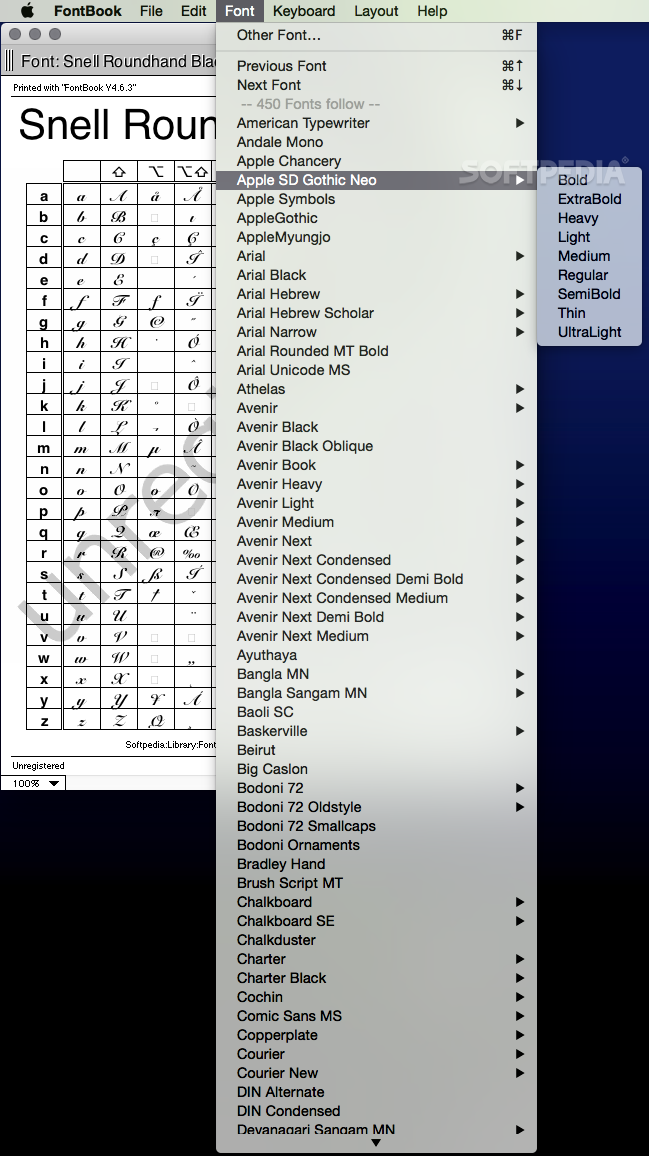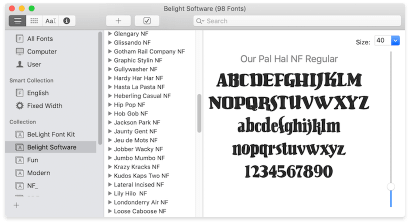

- #WHERE DOES FONTBOOK STORE FONTS HOW TO#
- #WHERE DOES FONTBOOK STORE FONTS UPDATE#
- #WHERE DOES FONTBOOK STORE FONTS CODE#

# It will include font family names like "Kaiti SC,楷體\-簡,楷体\-简" # Temporary file fonts-in-system.txt is generated But if you already have files with such names on your Desktop they will be overwritten! So be careful!"Įcho "Enter what you want to have displayed"Įcho "Do you want to have the fonts in normal (n), italic (i) or oblique (o) style?"Įcho "Do you want to have the fonts in normal (n), lighter (l) or bold (b) weight?"Įcho "Fonts are generated - you'll find them on your Desktop in 'fonts.html'." The next time you want to use the script, you only have to start Terminal, and type cd ~/DesktopĮcho "\n************************************"Įcho "Welcome to an overview of your fonts"Įcho "Advice: This script generates two files: fonts.html and fonts-in-system.txt, second one will be deleted again. Now you can generate the promised html-file :-) If you now repeat the "ls -l" command, you should see that the rights of fonts.sh changed to new x shows, that you can execute the file. But at the moment you don't have the right to execute it. In the line with the new "fonts.sh"-file you'll probably see something like first four signs mean, that you can read ( r) and write ( w) on this file. Then type the following, which will list all files on your Desktop - and also the just created fonts.sh ls -l Then open Terminal application and type cd ~/Desktop
#WHERE DOES FONTBOOK STORE FONTS CODE#
Then insert the code below and save the file as fonts.sh on your Desktop. Open a new file ( File -> New), click on Format and choose Make Plain Text. If you're familiar with scripts and Terminal and so on, save the code below with a name of your choice at a place of your choice. Designers have a tendency to collect, or more accurately hoard nice looking fonts, and as time goes on your font list can become quite an. Keeping fonts organized is a very real struggle that many of us have had to deal with at some point or another.
#WHERE DOES FONTBOOK STORE FONTS HOW TO#
I think it is not difficult, but you have to know how to open Terminal application. How Professional Designers Organize Their Fonts. So maybe this is a solution for you, too. If you remove Library Symbols and Text Styles with embedded fonts from a document you’re working on, the fonts they use will un-embed automatically.I had the same problem and wrote a script for an overview in a html-file. If you use a Symbol or style from a Library with embedded fonts, you’ll need to embed them manually by following the steps above. You can embed fonts in Libraries like any regular document so everyone that uses that Library will be able to access those fonts. You will also need to un-embed and re-embed fonts that have received updates, as we cannot detect updates automatically. Disable the checkbox next to the name of the font you wish to un-embed.įonts will un-embed automatically if you delete the text layers that use them from your document. Open your document with an embedded font and choose File > Document Settings… from the menu bar and head to the Fonts tab.
#WHERE DOES FONTBOOK STORE FONTS UPDATE#
Even if you don‘t embed any font, we‘ll still create an update with your latest changes. If you want to embed new fonts to an existing Workspace document, we‘ll show you the embedding fonts menu after you‘ve saved your document so you can pick which fonts you want to embed. We‘ll remember your choice for each Workspace, so you don’t have to embed fonts in every new document. Toggle the checkbox Select All to choose every font in your document or pick which fonts you want to embed individually. When you save a document to a Workspace for the first time, you can quickly select which fonts you want to embed when saving your document.

To embed one of them, enable the checkbox next to a font. You’ll see a list of all non-system fonts in your document. To embed a font, choose File > Document Settings… from the menu bar and head to the Fonts tab. It’s simple, but that’s all you need in order to keep things neat using Font Book and it can make a massive difference to your workflow. How to embed a font in the Document Settings If you find that someone has embedded your font into a document in your Workspace without the proper rights, please contact us and we’ll remove it from our systems. Please be aware that some font vendors do not allow users to transfer, display or distribute their fonts - and our terms of service prohibit embedding fonts without the correct license. So, before you embed any font, you must make sure you own the correct license, including the rights to distribute it. Important: We respect and value the work of font creators in the design community. Text layers that use the missing fonts will now show your chosen replacement font instead. When you’ve made your selection, choose Replace to finish. From here, you’ll need to select a replacement font family and weight. To replace a missing font in a document, choose the Replace… button next to any missing font you want to replace. In the Fonts tab you can manage different font settings in your document, such as missing fonts or embedded fonts.


 0 kommentar(er)
0 kommentar(er)
